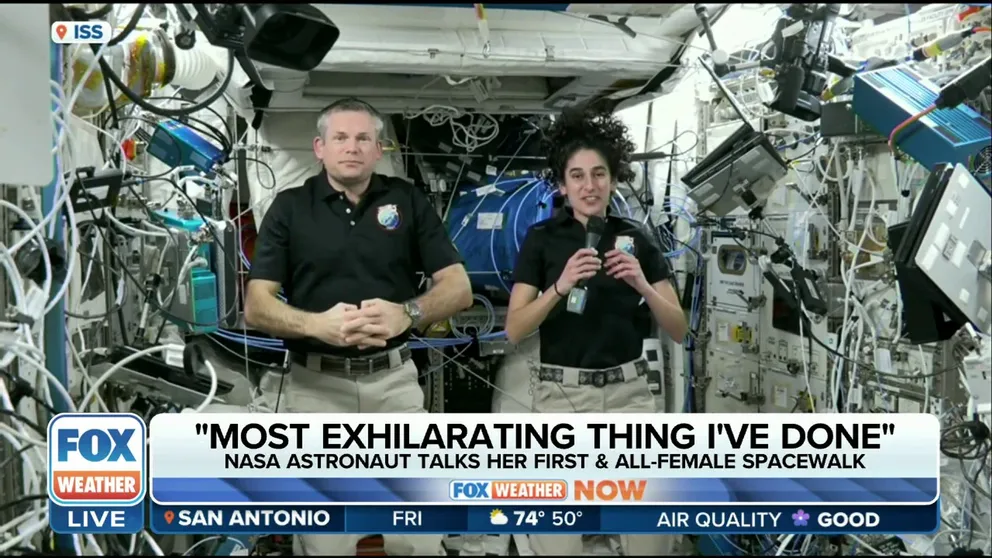Even short-term spaceflight causes changes in astronauts with rapid recovery on Earth
A series of studies used biomedical data collected during the private Inspiration 4 mission, NASA and JAXA missions. Scientists involved in the SOMA package say they are now able to say molecular changes can happen within days of spaceflight.
Astronauts aboard the International Space Station detail how weather looks on Earth from hundreds of miles away
FILE VIDEO: ISS astronauts provided a unique perspective to FOX Weather on lightning, solar eclipses and more.
Medical research into the biological effects of spaceflight took a giant leap this week after data from the first all-private mission, Inspiration 4, helped researchers worldwide reach new conclusions about low-gravity impacts on the human body.
On Tuesday, a series of research papers called the Space Omics and Medical Atlas (SOMA) package were published in the Nature Portfolio journals. The studies used biomedical data collected during the private Inspiration 4 mission, NASA and JAXA missions and led to 27 different scientific papers. The SOMA package is the largest publicly available spaceflight biomedical data yet.
Some of the most critical data from SOMA came from the four citizen astronauts who flew on a SpaceX Crew Dragon on the Inspiration 4 mission in September 2021. The mission was funded and commanded by American business executive Jared Isaacman. Hayley Arceneaux, Sian Proctor and Chris Sembroski joined Isaacman on a three-day flight into low-Earth orbit.
Scientists involved in the SOMA research from 25 countries were grateful to the Inspiration 4 crew for donating their skin cells, blood and more. Arceneaux and Sembroski joined some researchers on a call with reporters this week before the published findings to discuss their experience.
BOEING STARLINER SPACECRAFT DOCKS AT ISS WITH NASA ASTRONAUTS AFTER DRAMATIC APPROACH
"I love my space scars," said Arceneaux, a physician's assistant who served as the medical officer on Inspiration 4.
The crew took skin biopsies throughout their flight, which left scars.
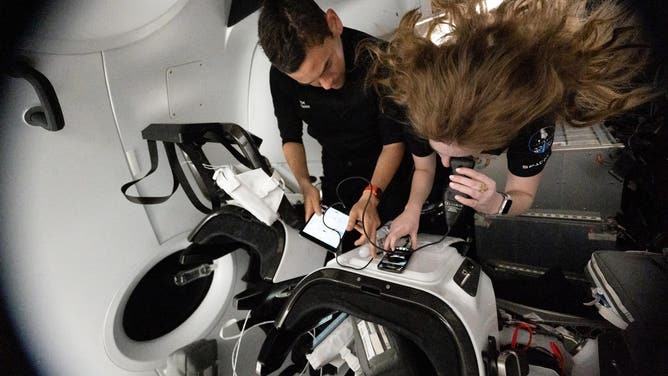
Inspiration 4 crew Jared Isaacman and Hayley Arceneaux conduct TRISH science in orbit.
(SpaceX/Inspiration4)
"I'm familiar with your DNA and your telomeres, but it’s nice to meet you," study co-author Susan Bailey, with Colorado State University, told the crew on a call.
Bailey's research studied spaceflight effects on telomeres, the caps at the end of our DNA chromosomes that shorten as people age, which makes them a good biomarker for health and aging. Data from NASA astronaut Scott Kelly's one-year mission surprisingly found that telomeres shortened during his spaceflight.
Researchers had a lot of data on missions that lasted longer than six months, but for the first time, they could see how quickly these changes happened using data from the three-day Inspiration 4 mission.
Bailey said they found telomeres for the crew also elongated over the three-day private mission. Data from more than 10 astronauts shows that telomeres elongate during missions.
Other changes in astronauts included elevated cytokine levels, gene expression changes for immune activation, DNA damage response and oxidative stress.
The crew also became "more alike" over their 3-day mission because of microbial exchange at close quarters.
Studies show the human body bounces back after spaceflight, but some changes remain
Study author Christopher Mason, of Weill Cornell Medicine, said they found that space explorers recovered from about 95% of biological changes returning to their baseline in the months after the mission.
"We think most of the changes we see are adaptive to spaceflight, that the body is clearly under stress because it's getting into microgravity. It has more radiation. It's a very unusual environment, you know, fluid shifts that disrupt the lymphatic system," Mason said. "Our bodies have evolved to live on gravity. Without it, it is a stress on the body."
SPACEX'S STARSHIP AND SUPER HEAVY BOOSTER MAKE EPIC SPLASHDOWNS IN GULF OF MEXICO, INDIAN OCEAN
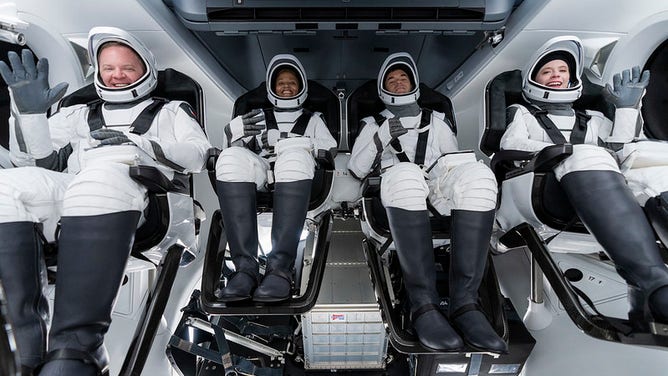
The Inspiration 4 crew inside the Crew Dragon spacecraft. (Image: SpaceX)
While most of these adaptive changes are temporary, telomere length is one change that did not completely return to pre-spaceflight levels.
Bailey said that the telomeres are essentially damaged during spaceflight, likely not because of microgravity but because of radiation.
"It's most likely it's just radiation exposure or radiation exposure in general and more of a chronic nature of the radiation or even in a few days, even in three to five days," Bailey said. "So those are all very important findings."
Mason said the information gleaned from the short spaceflight is helpful for more people who plan to fly in space and aren’t able to train for a decade for spaceflight. The Inspiration 4 crew trained over four months ahead of their launch.
The Inspiration 4 crew agreed to make their data public, avoiding some of the barriers scientists face in getting biomedical data from government astronauts and providing a plethora of new medical research opportunities. Previously, there was no way to access more than one data set at a time.
"The data is so rare and precious," Mason said.
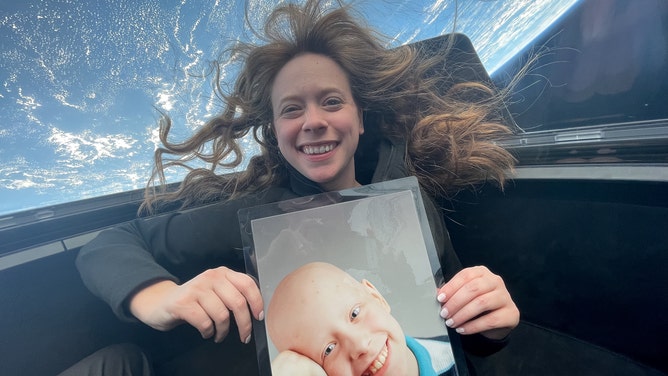
Inspiration 4 medical officer and crew member Hayley Arceneaux in orbit with a photo of herself as a child. Arceneaux is a childhood cancer survivor who later became a physician's assistant.
(SpaceX/Inspiration 4)
Afshin Beheshti of the Blue Marble Space Institute of Science led a countermeasures study focusing on ways to address some of the impacts of low gravity and diseases on Earth.
"Space is an accelerated model for aging and a lot of diseases, unfortunately. So then, you know, these countermeasures come up that can actually be easily applied to the clinic, to other diseases that are related," Beheshti said, such as osteoporosis.
With more space access and medical data, Beheshti said they repeatedly see the same effects across all space flyers.
"You can't deny that these effects are actually real because it's over and over," Beheshti said. "You see that, you know, different astronauts, different people, different backgrounds of people, genetic background, that these factors are there."
These studies can help develop protection for future space missions and on Earth, including radiation protection and anti-aging.
Inspiration 4 helps reveal differences in how men, women respond to spaceflight
Samples from the Inspiration 4 mission revealed the first evidence that men and women recover differently after their time in space.
Mason said that while both sexes quickly returned to baseline, there "seems to be a little bit of evidence that females return a bit more quickly."
He theorized that women could be better adapted to physical changes because of the ability to have children.
"We don’t have the full answer yet as to why women seem to be more tolerant to spaceflight," Mason said.
It's still too early for researchers to say that women make better space explorers than men biologically. The researchers estimated they would need a few hundred more astronaut samples to confirm this theory. According to the Supercluster Astronaut Database, less than 100 women have been to space, whereas more than 600 men have.
Even though this new research shows women can bounce back a little faster, Bailey said that comes with a caveat.
JAPANESE BILLIONAIRE CANCELS SPACEX STARSHIP FLIGHT AROUND MOON, DASHING DREAMS FOR SELECTED CREW

Inspiration 4 crew Sian Proctor (left) and Hayley Arceneaux (right) in orbit.
(SpaceX/Inspiration 4)
"A word of caution is that some of the work has shown that females may be more susceptible to some of the radiation-induced cancers like breast and lung," Bailey said. "There is always a flip side to the coin."
Future studies might look at how different sexes and ages react to spaceflight.
Scientists said the Inspiration 4 crew was a good study sample because the astronauts included both sexes and ages from four different decades. At 29, Arceneaux was the youngest American to orbit Earth.
"We have this huge range now of ages," Bailey said. "It's just really a remarkable opportunity to see how different people respond."
Both Sembroski and Arceneaux said they would go back into space "in a heartbeat," but they realized a need to provide more space access.
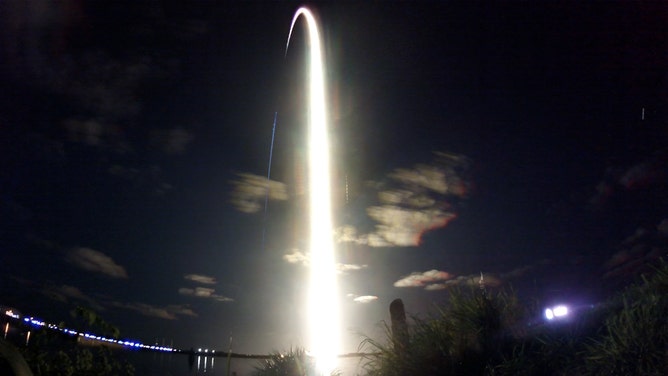
Time-lapse image of the Inspiration 4 launch. (Photo: Chris Boex / FOX)
"It was amazing to know that we went into this mission knowing that, yeah, we might be the first civilian crew, but we were going to make sure that we were not going to be the last," Sembroski said.
Arceneaux said she hopes more people can experience seeing the Earth from space, also known as the overview effect.
"What I'm hearing today is we need more data," Arceneaux said. "So we need to get more people up there."
